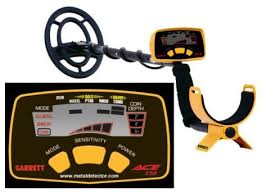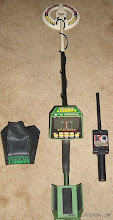Metal Detecting for fun or profit can be one of the most exciting and rewarding of hobbies. A metal detector can cost very little, as low as $50 or higher that $400 for a top of the line model. This is one hobby where you really do get what you pay for, because the more expensive top of the line detectors use the most advanced technology and they have the best features available.
Metal Detectors use one of three types of technology:
 BFO (Beat Frequency Oscillation) - Metal Detectors using BFO technology have two coils of wire, one large coil is located in the search coil of the detector, the other small coil of wire is located within the System Control Pack. Each coil of wire is connected to an oscillator that produces pulses of current. These pulses of current pass through the coils generating radio waves. A receiver housed within the System Control Pack receives the radio waves and makes a series of tones based upon the frequencies of the radio waves. When the detector search coil passes over a coin or other metal item a magnetic field is created around the coin or metal item, this magnetic field causes interference with the frequency of the radio waves generated by the search coil. And changes the tone produced by the receiver.
BFO (Beat Frequency Oscillation) - Metal Detectors using BFO technology have two coils of wire, one large coil is located in the search coil of the detector, the other small coil of wire is located within the System Control Pack. Each coil of wire is connected to an oscillator that produces pulses of current. These pulses of current pass through the coils generating radio waves. A receiver housed within the System Control Pack receives the radio waves and makes a series of tones based upon the frequencies of the radio waves. When the detector search coil passes over a coin or other metal item a magnetic field is created around the coin or metal item, this magnetic field causes interference with the frequency of the radio waves generated by the search coil. And changes the tone produced by the receiver. Metal Detectors using BFO technology are the ones your likely to get when paying under $100 for, that's right, the cheapest. The BFO technology is the easiest and cheapest to make, thus the prices of the detectors are cheap. The only problem is, BFO technology is very limited when compared to PI and BFO detectors, and the ability to distinguish between junk metals and silver or other coins is very poor.
 PI (Pulse Induction) - Metal Detectors using PI technology sometimes use a single coil or a series of coils working together as a transmitter and receiver. Short bursts of electrical current are send through a coil of wire, causing a magnetic field. When the burst of electrical current ends the magnetic field reverses polarity. A sharp electrical spike is created, then more pulses are created, the whole process repeats and works like a series of echoes, giving a different report or echo depending upon the metal it encounters. This type of metal detector is not very good for discrimination between different types of metals or coins, but it is good to use where some other types of metal detectors have trouble working, such as in salt-water, and metals can be detected much deeper with this technology than the others.
PI (Pulse Induction) - Metal Detectors using PI technology sometimes use a single coil or a series of coils working together as a transmitter and receiver. Short bursts of electrical current are send through a coil of wire, causing a magnetic field. When the burst of electrical current ends the magnetic field reverses polarity. A sharp electrical spike is created, then more pulses are created, the whole process repeats and works like a series of echoes, giving a different report or echo depending upon the metal it encounters. This type of metal detector is not very good for discrimination between different types of metals or coins, but it is good to use where some other types of metal detectors have trouble working, such as in salt-water, and metals can be detected much deeper with this technology than the others.  VLF (Very Low Frequency) - Metal Detectors using this technology have two search coils. One coil called the 'transmitter coil' transmits electricity rapidly many times per second, first in one direction around the coil, then in the other direction. The other coil called the 'Receiver Coil' acts just like the name implies it receives frequencies or data that come or 'bounce' back from the objects the transmitter coil detects in the search area. This type of Metal Detector is great for it's ability for being able to distinguish between different types of metals.
VLF (Very Low Frequency) - Metal Detectors using this technology have two search coils. One coil called the 'transmitter coil' transmits electricity rapidly many times per second, first in one direction around the coil, then in the other direction. The other coil called the 'Receiver Coil' acts just like the name implies it receives frequencies or data that come or 'bounce' back from the objects the transmitter coil detects in the search area. This type of Metal Detector is great for it's ability for being able to distinguish between different types of metals. The first metal detector my wife and I bought together cost about $69.00 it was one of them cheap ones that used the 'BFO' technology. This was one of them metal detectors you see in the magazines that sell other household items, etc. You can buy cheap metal detectors like these at most Radio Shack stores, and some K Marts and Wal Marts. The first day we took the metal detector outside we started finding some Nert things and my wife and I were hooked. We did find our share of junk items in the yard, like aluminum foil, nails and the usual pull tabs and junk metal. But we also found 7 old diecast cars in great condition. They were all different and were 'TOOTSIE' diecast vehicles. I looked on eBay and the bunch was worth around $15 or more. We also found a 1961 silver Roosevelt dime in fine condition, in our yard, plus the usual pennies.
After reading about how the 3 different types of Metal Detector technologies work and differ from each other, you must decide how or what you will be mostly using your metal detector for. Will you be hunting for small objects like coins, jewelry and gold nuggets, or searching for a large cache or object. The things you may want to use your detector for, play one of the most important factors besides pricing in deciding what type of detector to buy. Most folks want a detector that is great at finding coins, gold nuggets, and jewelry on the land and in small creeks and streams, this would be a detector using 'VLF' technology. Almost all of the modern detectors have a waterproof search coil which make searching in shallow creeks and streams possible.
There is Computer Software that is made just for the hobby of Metal Detecting. The software is called: Metal Detector - Treasure Hunter Professional, and may be seen at this website address: http://www.rb59.com/md/meal.html Read More....
By Robert W. Benjamin
Metal Detecting



